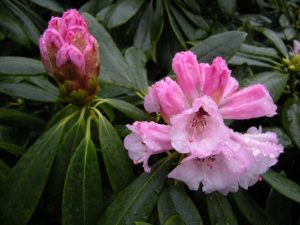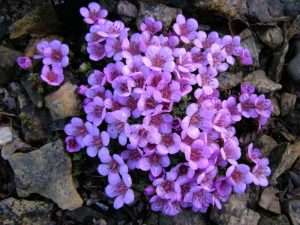Rhododendron praevurnum is a huge evergreen species reaching 4 metres across and 3 metres high and is characterised by the distinctive blotch of wine-red colour on the inner corolla at its upper base. Bud development is deep pink on development, opening and ageing with style to a shade of white.
The flower bud formation is quite regal in the way it develops and expands throughout late February, providing the best show of flowers during mid-March. This rhododendron is native to Central China, notably the provinces of Szechuan and Hupeh, from where it was introduced to Britain in the late 1800’s.
The RHS give this species a zone 7 marking in terms of hardiness zones, which relates to the USDA plant hardiness mapping. In Britain, this species will survive where the average minimum annual temperature is down to -12.3 to -17.8 degrees Celsius. Although fully hardy, the flowers can be devastated by early sun after an overnight frost.
As a contrast, the alpine trough to the west of the Temperate Palm House is home to a miniature floriferous power pack. Saxifraga oppositifolia was collected in eastern Greenland by George Argent in 1974. Deep purple petals open and fade almost to white. Its dense, ground-hugging cushion – only extending 20mm in height when in flower – is a necessary habit considering its geographical range through the arctic and high mountains of Europe. Other forms are cultivated in the Rock Garden scree where again a free-draining root zone is provided. There is a pot grown example, growing in the north alpine frame. In this sheltered microclimate the growth is very straggly.
This perennial herb is hardy to -45.1 degrees Celsius or zone 2 by USDA standard. Though at home in arctic bog and tundra, it adapts well to cultivation. It is a British native, so if you miss it at the Botanics, look out for the splash of purple when walking in the Scottish hills.


